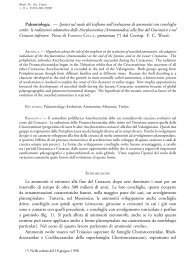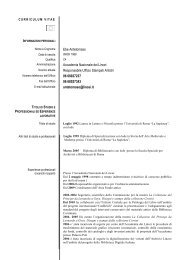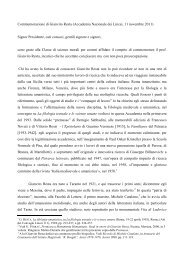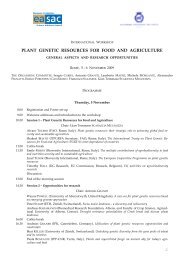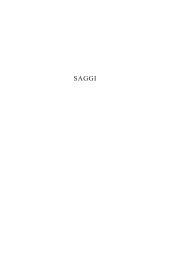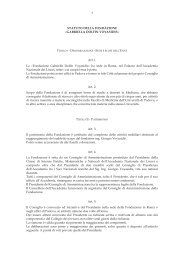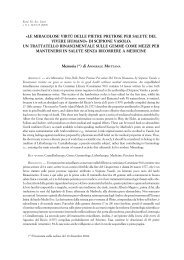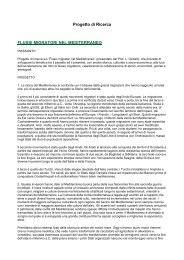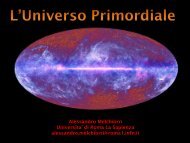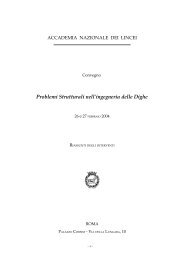Bollettino dei Classici - Accademia Nazionale dei Lincei
Bollettino dei Classici - Accademia Nazionale dei Lincei
Bollettino dei Classici - Accademia Nazionale dei Lincei
You also want an ePaper? Increase the reach of your titles
YUMPU automatically turns print PDFs into web optimized ePapers that Google loves.
10<br />
modern editors, who often join two or three cola of M together and in doing so sometimes overshadow metrical and<br />
textual symmetries.<br />
III. (P. Volpe Cacciatore): At Aesch. Pers. 732 the interpretation of oujdev ti" gevrwn is problematic; West and,<br />
recently, Garvie have opted for the cruces desperationis. I propose to keep the manuscript text, introducing a sign of<br />
aposiopesis after gevrwn to mark the sudden breaking off of tbe sentence at the end of the line: the queen's words are<br />
suddently stopped by Darius' following exclamation, which would explain the ellipsis of the verb. I think that the<br />
implied verb could be oi[cwke, with its double meaning of "to go away/to die", At 736 I accept Page's (and<br />
Garvie's) e}n duoi'n zeukthvrion, with the meaning, "one thing you yoking two".<br />
IV. (S. Novelli): The paper concerns the anapaestic clesis and is focused on assuming that the manuscript text and<br />
this ancient colometry are highly plausible. Retracing the exegetical history of the passage, the author discusses the<br />
main semantic and metrical problerns: specifical1y, at v. 822 megavle violates the Wifstrand's rule but is defended<br />
by perspicuous tragic parallels; at v. 826 ajsinei' is semantically congruous, as well as many poetic examples clearly<br />
attest in caivrw+living subjects (here swth'ri); at the same rime, ajtevknou" conforrns to the context and to<br />
Aeschylus' dramaturgic choices (v. 827); on the metric level, it is not neeessary to postulate a lacuna at vv. 824s.<br />
and 830, while the sequenee of four breves between dactylic and anapaestic metron at vv. 827s. is not total1y<br />
unusual in attic theatre; the variant attested in the Mediceus, rJuvesqe, and the break of synapheia at v. 824 are<br />
supported by v. 304 and some euripidean loci similes. These lexicaI, metrical and stylistic peculiarities are perfectly<br />
adequate to the aeschylean language and support the hypothesis that these anapaests were pronounced as lyrical<br />
verses and not as recitative ones.<br />
V. (F.G. Giannachi): This paper examines the manuscript tradition of the first stasimon of Sophocles' Antigones and<br />
in particular its layout in the ms. Marc. gr. Z 617 (=810) of the 14 th century, where are found some emendations to<br />
the metrical division of the cola. We try to recognize the author of the corrections and the time in which they are<br />
made, also comparing manuscript with its apograph for the Sophoclean text Pal. gr. 287.<br />
VI. (M. Lazzeri): In Soph. fr. 582 R., beIonging to the lost tragedy Tereus, some scholars (and the same Radt)<br />
reject the lectio sevla" and accept Bothe's emendation sevba". Neverthless, some observations (such as the<br />
occurrences between {Hlio" and sevla", some tragic examples - especially Aesch. Sept. 390-391, Soph. El. 17-18,<br />
Eur. El. 866 and Tr. 860 - and the comparison between Sophoc1es' fragment, Eur. Phoen. 3 and Theodect. fr. 10, 2<br />
Sn.-Kann.), suggest that the lectio sevla" should be quite legitimate, and can therefore be preserved.<br />
VII. (T. Raiola): This contribution deals with a textual problem in the greek tradition of Galen's Commentaria in<br />
Hìppocratis Epidemiarum librum VI (304, 13-306, 19 Wenkebach-Pfaff). With the support of the arabic translation<br />
of IXth century by Hunain ibn Ishaq, and considering Galen's usus scrìbendi, the author tries to reconstruct a better<br />
text, supposing the existence of a lacuna in the greek textual tradition of the Marcianus Venetus 283 manuscript,<br />
together with a significant interpolation due to an error made by the copyist.<br />
***<br />
Serie terza – Fascicolo XXXII (2011)<br />
M. T. Luzzatto, Commentare Demostene (Le strategie dell'hypomnema nel Didimo di Berlino)…….…… Pag. 3<br />
T. Raiola, Galeno, commento a Officina medici (Un nuovo incipit per il III libro)………………………..… " 73<br />
A. Tessier, Piccola storia di un accento euripideo: Oreste 140 e Dionigi di Alicarnasso, C. V. 11………... " 85<br />
P. Janni, L'aurora, il giorno e la notte (Testimonianze su luce e tenebre nella poesia e nella filosofia<br />
antiche)……………………………………………………………………………………………………. " 93<br />
P. D'Alessandro, Endecasillabi faleci e sistemi ionici nelle Menippee di Varrone (con un excursus su Laev.<br />
fr. 8 Blansdorf 2 )……………………………………………………………………………………………..………. " 131<br />
Nota della Redazione……………………………………………………. …………………………...………" 165<br />
ABSTRACT




